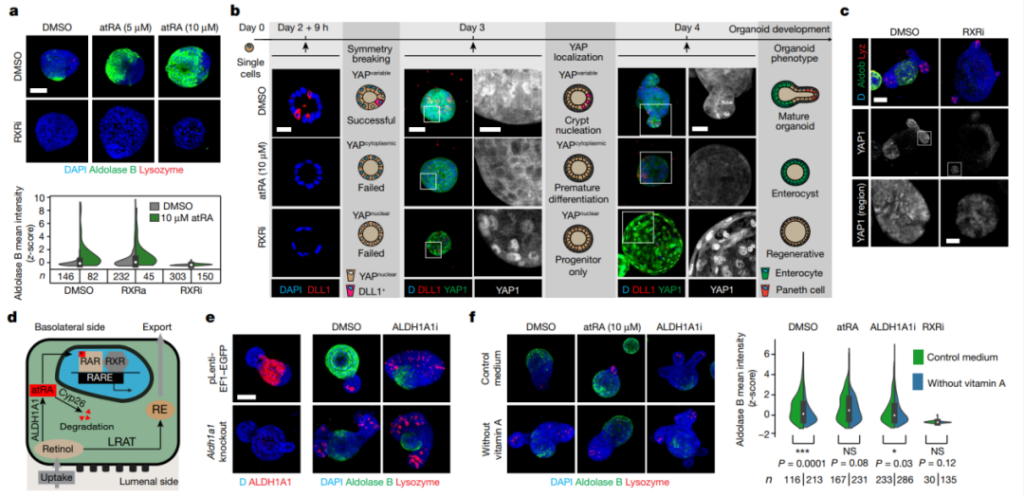Nature: Intestinal organoids to identify intestinal organoid phenotype profiles
- Normal Liver Cells Found to Promote Cancer Metastasis to the Liver
- Nearly 80% Complete Remission: Breakthrough in ADC Anti-Tumor Treatment
- Vaccination Against Common Diseases May Prevent Dementia!
- New Alzheimer’s Disease (AD) Diagnosis and Staging Criteria
- Breakthrough in Alzheimer’s Disease: New Nasal Spray Halts Cognitive Decline by Targeting Toxic Protein
- Can the Tap Water at the Paris Olympics be Drunk Directly?
Nature: Use intestinal organoids for high-throughput drug screening to identify intestinal organoid phenotype profiles
Nature: Use intestinal organoids for high-throughput drug screening to identify intestinal organoid phenotype profiles. During the development and differentiation of intestinal organoids, RXR inhibition is applied, and the organoids will maintain the regenerative phenotype, and will not differentiate into intestinal epithelial cells and Paneth cells, and their intestinal specificity will gradually be lost.
In the past ten years, organoids from a variety of tissue sources can exhibit the cellular composition and multiple functions of related organs, and have been proven to be perfectly suitable for experimental operations and become a new type of in vitro cell tool for research.
Organoids derived from the intestine can not only strictly reflect the structure of intestinal cells and the types of intestinal cells, but also show the regeneration ability after intestinal tissue injury, making the intestinal organoids widely studied and used [1].
In 2019, the team of Professor Prisca Liberali from the Friedrich Miescher Institute of Biomedical Research (FMI) in Basel, Switzerland published “Self-organization and symmetry breaking in intestinal organoid development” on “Nature”. This article uses single-cell genomics and imaging to study the formation of intestinal stem cells and the molecular mechanisms involved in symmetry breaking in two organoids LGR5+ and LGR5-[2], confirming that organoids are capable of In vitro culture has a 3D structure and can highly summarize the differentiation potential of stem cells. It is an excellent model for studying the progress of single cell symmetry breaking.
In October 2020, the University of Basel in Switzerland and the Novartis Institute of Biomedical Research re-published the latest research results “Phenotypiclandscape of intestinal organoid regeneration” in the journal Nature, which uses intestinal organoids for high-throughput drug screening and identification of intestinal organoids Phenotypic map, and exploring the regulatory effects of RXR receptor inhibitory drugs on the proliferation and differentiation of intestinal organoids, showing for the first time a functional gene interaction map that regulates organoid development and self-organization [3].
In the article, the researchers first screened 2789 compounds by using a model that single cells differentiate into intestinal organoids over 4 days, and observed the effects of these compounds on the growth and differentiation of intestinal organoids. Among them, Enterocyst is intestinal epithelial cell, which absorbs water and nutrients from the digestive tract, and Panethcell is Paneth cell, which functions similarly to neutrophils (Figure 1).

figure 1
The results showed that organoids treated with activity controls (ie, the γ-secretase inhibitor DAPT and the glycogen synthase kinase-3β (GSK-3β) inhibitor CHIR99021) can be regenerated and can produce effects under specific conditions. The researchers used high-throughput imaging of intestinal epithelial cells, Paneth cells, DNA and proteins, and used PhenoGraph to generate 15-element fingerprint clusters for the intestinal organoids treated with the compound (Figure 2). Then by reducing the resolution of the phenotype, it was summarized into 7 major phenotypes. The most common phenotype is the “wild type” phenotype (class 1-3, “mature organoids”) (Figure 3).

figure 2

In order to study what genes in the regenerative phenotype regulate the regeneration and differentiation of organoids, researchers used the method of inhibiting and stimulating RXR to observe its effects on organoids. The results found that in the early organoids, the inhibition of RXR can maintain the organoid regeneration state, prevent symmetry destruction, restrict YAP1 expression in the nucleus, and control the nuclear transport of YAP1. At the same time, it has been proved that retinoic acid metabolism is necessary for the differentiation of intestinal epithelial cells, but it is not for Paneth cells (and does not affect YAP1 expressing regenerative cells), and intestinal epithelial cells obtain regional specificity through the intracellular synthesis of atRA cells controlled by ALDH1A1 ( Figure 4).

Figure 4
Conclusion: During the development and differentiation of intestinal organoids, RXR inhibition is applied, the organoids will maintain the regenerative phenotype, and will not differentiate into intestinal epithelial cells and Paneth cells, and their intestinal specificity will gradually lose. It also shows that the use of multiple phenotypic screening methods in the development of organoids to identify physiologically relevant targets that can be studied in vivo can be used to reveal the mechanism of intestinal regeneration.
(source:internet, reference only)
Disclaimer of medicaltrend.org



